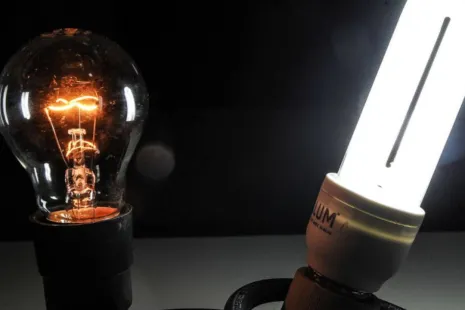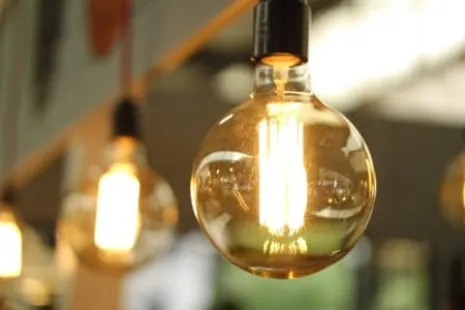Choosing a light bulb quickly and easily
Added 26.1.2022 11:49.48
Choosing the right light bulb is a more difficult task than it may seem at first glance. In today's article, we explain how to master it easily, quickly and successfully.
With us, you'll know right away where you stand
We supply crystal chandeliers, ceiling lights, wall lights, lamps and other ArtCrystal Tomes products without bulbs. So it's up to you and your discretion which one you choose. However, for each lighting, we indicate which bulbs of what wattage we recommend for that model.
These are almost always traditional clear glass bulbs. These, unlike plastic or milky coloured bulbs, do not diminish the brilliance of the crystal when the chandelier is lit. You'll usually find the recommended socket type there as well.
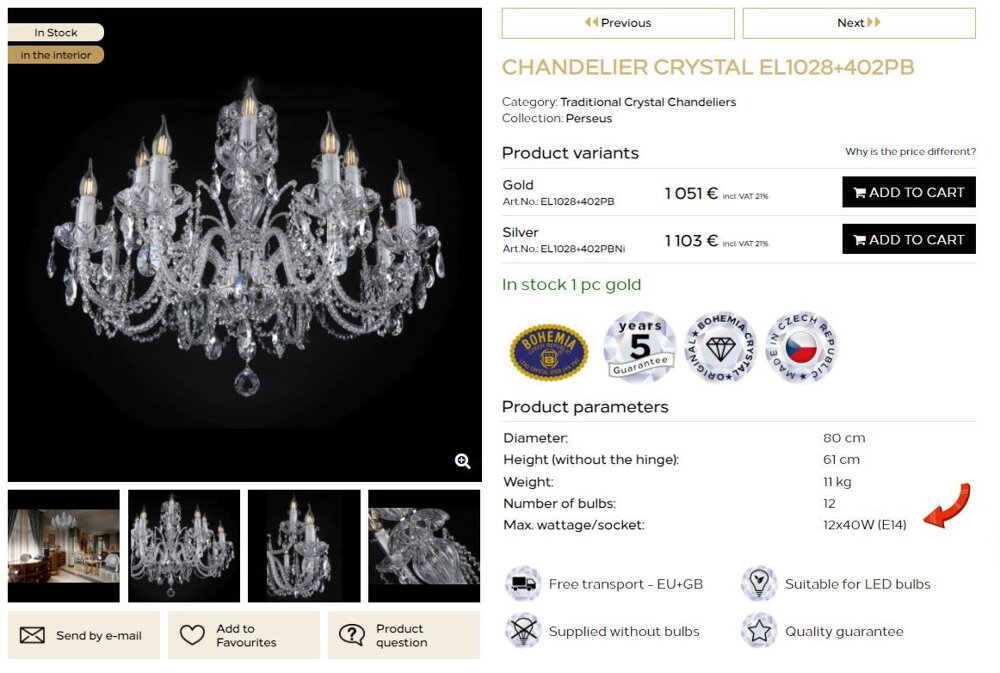
A suitable bulb base is essential
And just the right kind of thread is the first thing you should know when you have already chosen or even bought a light fixture and are thinking about what kind of bulb to get for it.
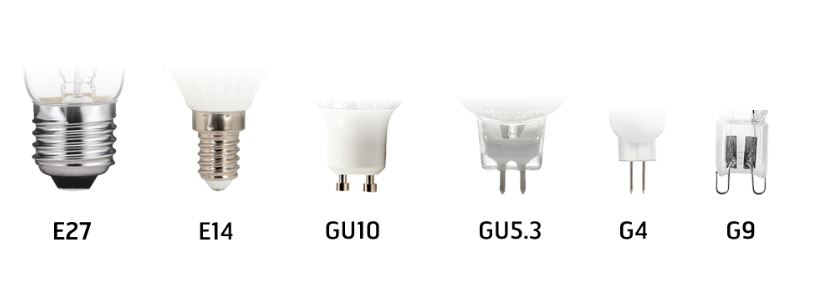
It has to be a bulb with a suitable base. And this can vary from one type of light to another. Our crystal chandeliers are usually fitted with standardised threads for E14 or E27 bulbs, while spot ceiling lights usually have GU10 bulbs. And wall lights and lamps are mostly compatible with E14.
With the socket type sorted out, you can now start thinking about the bulb type.
Types of bulbs
1. LED bulbs
Today, our designers are able to incorporate new technologies and manufacturing processes into even classic crystal chandeliers. As a result, you can safely use an LED bulb not only in modern lighting fixtures but also in traditional crystal chandeliers.
Of course, there are some exceptions to this rule, so you can find out immediately on each product page whether LED bulbs are suitable for it or not.
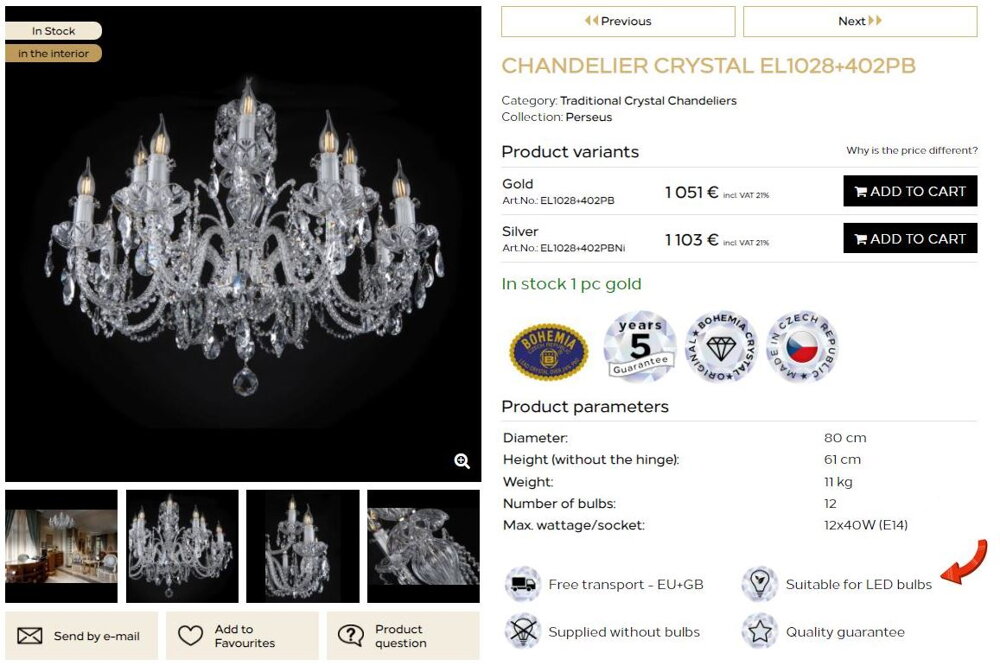
LED bulbs are currently the most popular bulbs for chandeliers and pendant lights. It's no wonder - they have a lifetime of up to 25,000 hours, instant onset of light and safe operation. They also excel in low consumption. Their price is higher, but compared to conventional bulbs, they save over 80% energy. And that's clearly worth it in the long run.
2. Energy saving bulbs
Energy saving bulbs are fluorescent lamps with accessories in a compact form, which is why they are often called compact fluorescent lamps. Compared to conventional bulbs, they save up to 70% energy, but their lifetime is one-third to half that of LED bulbs.
They come in a variety of shapes. The big disadvantage, however, is the slow onset of light, for which you have to wait at least 30 seconds. In addition, switching them off and on shortens their lifespan, which is why they are particularly useful where you need to light for longer periods of time.
3. Halogen bulbs
Halogen bulbs have the same shape and colour of light as conventional bulbs, but are about 30% more energy efficient. They have twice the lifetime of 2 000 to 3 000 hours. When switched on, they start up immediately at full power and, although their price is lower than LED bulbs, they are considerably more expensive to run. For this reason, they are mainly used where the light is frequent and short-lived.
4. Conventional bulbs
Conventional bulbs are still freely available, although the import and sale of conventional bulbs has long been banned under EU Regulation 244/2009. Manufacturers get around it by labelling them as heat sources, heat cells or industrial lighting bulbs.
They are the cheapest light source by price, but very inefficient. Up to 90% of the energy consumed is converted into unnecessary heat, while only 10% is converted into light. Their lifetime is also low, around 1 000 hours. However, they also have pros, which include a pleasant warm light, dimmability, excellent colour rendering and instant onset of 100% luminosity.
Do you have an idea of which type of bulb you prefer? Great. Let's move on to your desired light color.
The colour of the light
The colour of light, otherwise known as chromaticity temperature, is given in Kelvin (K) and tells us what shade a given bulb emits.
Determining the exact value is difficult. In simple terms, bulbs or luminaires can be divided into three main categories: warm white, white and cool white.
Let's take a closer look.
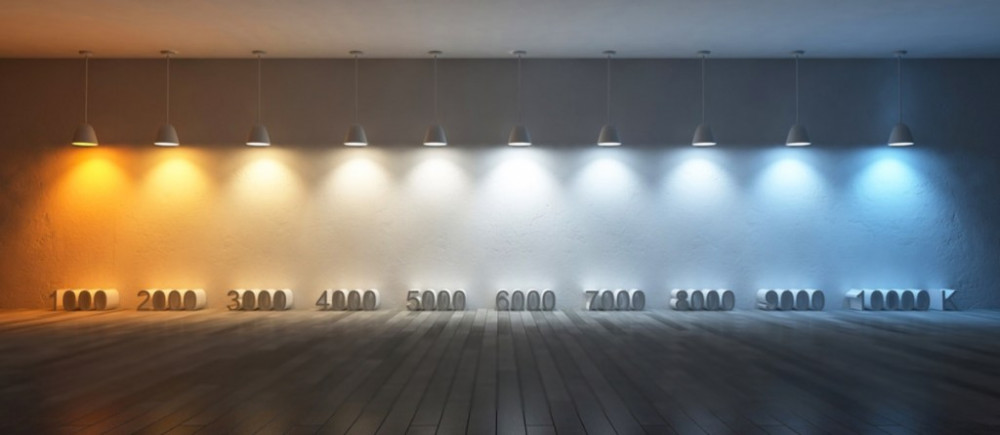
1. Warm white (approx. 2200-3300 K)
Lamps that glow in yellow and orange shades. They resemble the light of a candle or a fire. Their colour has a pleasant, cosy and relaxing effect. They are suitable for rooms where you want to create a relaxed atmosphere.
2. White (approx. 4000-5000 K)
Sometimes referred to as neutral or day white. The reason is simple - its glow is close to daylight, which reaches between 5000-7000 kelvin at midday. It minimally affects the surrounding environment and gives a pleasant, harmonious feeling.
3. Cold white (approx. 5500-8000 K)
A stark white light that picks up blue hues as the number of degrees on the Kelvin scale increases. The colour significantly brightens the environment in which it is used. With increasing chromaticity temperature it may no longer be too dazzling for some.
Need more information? Find it in the article What is the ideal light temperature. Do you have a colour selected? Great. That means we can now finish our bulb selection by choosing the optimum light intensity.
Light intensity
The most important criterion when choosing a bulb is its luminous intensity, which is given in lumens - units of luminous flux. This means how bright the light will be. The luminous intensity represents the fraction of the luminous flux falling on a specific area. It is given in lux.

Appropriate lighting intensity is an essential part of maximum comfort, as we need to be able to see clearly under our hands when cooking, whereas we prefer more subdued light in the bedroom.
Recommended lighting intensity by room
- Bedroom, living room, children's room - 200 lx
- Kitchen, bathroom, porch - 150 lx
- Hallway - 100 lx
Recommended intensity by activity
- Cooking - 500 lx
- Reading - 300 lx
- PC work - 400 lx
The recommended light intensity is therefore variable. And for example, the appropriate lighting intensity for the living room will depend on whether you want to read, work or sit down with friends or family for a social game. That's why it's usually not enough to have just one light source and you need to add a wall light or lamps to the ceiling light - and combine their intensity as you like.
For more information, see the article How to choose the light intensity?
We are here for you
We believe you can now quickly and easily choose the right bulb for your chandelier or other lighting. But do you still need advice? Contact us. We will be happy to help you. And together we will tune your home to the tones that suit you best.






































